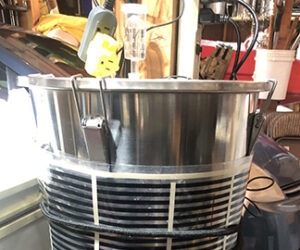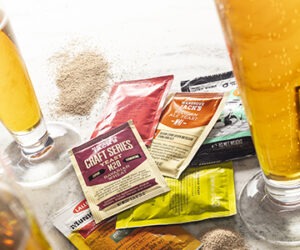Brewing With Lactobacillus

Why does Brettanomyces get all of the attention when it isn’t even responsible for making sour beers sour? Lactobacillus can do in a week what takes Pediococcus a year! Lactobacillus needs a publicist (or maybe a hype man).
Traditional mixed-fermentation sour beers (i.e., those where a wide variety of bacteria and yeast work together) take between a few months and a couple years to reach the desired level of acidity and complexity. While sour beers are rapidly gaining popularity, many homebrewers don’t have enough interest (or fermenters) to age beer that long! Enter Lactobacillus. An active culture, pitched into minimally-hopped wort without competition and held warm can produce enough lactic acid to sour a beer in less than a day.
A slow fermentation with many microbes may result in a more interesting flavor profile, but this characteristic is often obscured when brewers produce passion fruit Berliner weisses, Amarillo® dry hopped sour blondes, and tart pink peppercorn citrus zest session ales.
Biochemical Nerdery
Lactobacillus is a genus of bacteria, specifically Gram-positive lactic-acid-producing bacteria, often lumped together with Pediococcus when it comes to souring beer. Under the right conditions Lactobacillus can produce lactic acid quicker than its hardier cousin, and generally does not leave behind the diacetyl or exopoly-saccharides (“sickness”) that require cleanup by Brettanomyces. Lactobacillus is able to reproduce quickly with some species capable of doubling every 20–60 minutes (meaning that each cell at T=0 can result in offspring num-bering millions or billions in just 24 hours!). Sounds pretty ideal: No unpleasant byproducts, grows quickly in a wide range of temperatures (depending on species), sours rapidly, and as an added benefit is a probiotic!
The high growth rate of Lactobacillus is one reason why sour mashes are possible. Given the right conditions (i.e., warmth, low oxygen, pH below 4.5) a small amount of Lactobacillus present on the grain can dominate all the other wild microbes living on malt. However, if these conditions aren’t maintained perfectly, other far less pleasant microbes can announce their presence by making your house smell like a garbage-dump in the middle of a heat wave. Even under ideal conditions, wild Lactobacillus does not always produce as much acidity as the brewer wants.
Before you claim that sour mashes are a traditional part of the process, stop. You’re wrong (unless you’re talking about Tennessee whiskey). Sour mashing is not a common current or historic technique in Germany for producing Gose or Berliner weisse.
Most species of Lactobacillus are quite sensitive to hop compounds. In fact, when brewers (even lambic brewers) talk about the “protective” power of hops, Lactobacillus is the chief microbe they are inhibiting. Isomerized alpha acids prevent Lactobacillus from reproducing by damaging their cell membranes. While there are some moderately hop-tolerant strains, we suggest keeping the IBUs below 5 if you are souring with Lactobacillus. At that sub-flavor-threshold amount there is hardly a reason to add any bittering hops!
The trick is that most Lactobacillus sold for brewing produce a variety of compounds in addition to lactic acid. Heterofermentative species (e.g., L. brevis, L. buchneri) convert carbohydrates into lactic acid, ethanol, carbon dioxide, and a small amount of vinegary acetic acid. Homofermentative species (e.g., L. delbrueckii — although not White Labs’ WLP677 — according to Neva Parker, their Head of Laboratory Operations) are capable of producing approximately twice as many molecules of lactic acid from a given amount of carbohydrate because they do not produce ethanol or carbon dioxide. There are also facultative species (e.g., L. plantarum), which can switch between the two depending on the conditions. Lactobacillus species are a diverse group, with some better suited to the production of sour beers than others.
Experiment
In order to better understand how different Lactobacillus behave during solo-fermentations, we decided to measure the drop in pH produced by the most common Lactobacillus species available to homebrewers. The four species we selected were L. buchneri (Wyeast 5335), L. brevis (White Labs WLP672), L. delbrueckii (White Labs WLP677), and L. plantarum (one isolate from Omega Labs OYL-605 Lactobacillus Blend). We inoculated an equal amount of each species into unhopped wort with an original gravity of 1.040 and placed at 86°, 99°, 102°, and 108° F (30°, 37°, 39°, and 42° C). We measured the pH of each sample six times over the course of five days.
As a brief chemistry refresher: pH is a logarithmic scale that describes how acidic or basic a solution is. 7 is neutral, and anything lower than that is acidic. A pH of 3.5 (typical for a finished sour beer — Goose Island Juliet among others per http://embracethefunk.com/ph-readings-of-commercial-beers/) is 10 times more acidic than 4.5 (typical for a non-sour beer), and 100 times more acidic than 5.5 (typical for the mash).
Results
Each Lactobacillus species lowered the pH of the wort, but there were significant differences with respect to how acidic the beer became and how the species responded to the different temperatures. Having a species capable of lowering the pH quickly and over a wide range of temperatures is ideal for real-world homebrewing applications. (Refer to the results charts at the end of the story.)
L. buchneri had the least visible growth during the experiment, but still lowered the pH more than L. delbrueckii. L. brevis and L. plantarum dropped the pH more than the other two species in a relatively short amount of time at every temperature tested. Despite the reputation for Lactobacillus benefitting from warmer temperatures, L. plantarum was able to lower the pH slightly more rapidly at cooler temperatures compared to higher temperatures (although even the coolest temperature was quite warm compared to most ale yeast fermentations).
While all four species were able to drop the pH of the wort, L. plantarum and L. brevis were able to get the pH of the wort to 3.2–3.4 (an ideal range for many sour beers) at a variety of temperatures. L. buchneri was able to adequately sour the beer at 99 °F (37 °C), but struggled to do so at temperatures slightly above or below that. L. delbrueckii remained above pH 4 at all temperatures tested. For comparison, the final pH of many non-sour beers is in the low 4s, making L. delbrueckii unsuitable for sour beers produced in this way.
Figure 1 (below) shows the final pH at 120 hours achieved by each species at all temperatures tested.
Figure 2 (below) compares the pH drop over time averaged across all experimental temperatures to provide a general sense of how each species performed.
Put the Results to Work
While some Lactobacillus species produce alpha-glucosidase, which allows them to ferment complex dextrins, many thrive only early in fermentation when simple sugars are available. As a result, pitching Lactobacillus after primary fermentation can result in only minimal souring. In the above experiment, the pH dropped the greatest amount in the first 24 hours for all four species we tested.
To quickly sour a beer your process can be as simple as: chill the wort from the boil to the target fermentation temperature in your kettle, pitch an active Lactobacillus culture, affix the lid, and hold the temperature as steady as you can until the desired acidity is reached. At this point you can bring the soured wort up to 150 °F (66 °C) for 30 minutes to pasteurize before chilling and pitching yeast. The advantages of kettle souring compared to sour mashing are speed, reliability, and cleaner flavors. Paired with pasteurization, kettle souring carries no risk of accidentally souring other batches. If you do not want to pasteurize, after the wort is chilled to the desired souring temperature transfer it to a fermenter. Once the desired acidity is attained pitch brewer’s yeast. This does carry cross-contamination risks, so we recommend using a separate set of post-boil equipment that will not come in contact with non-sour beers.
Now that we know how to produce a beer with loads of lactic acid quickly, time to address the issues that come with souring a beer before pitching the brewer’s yeast.
#1 Destruction of proteins beneficial to head formation and mouthfeel.
One strategy to minimize the negative effects of protease activity by Lactobacillus is to lower the starting pH of the wort to around 4.5 (Sanz et al. 2001 Applied and Environmental Microbiology). This can be accomplished by the addition of a food grade lactic acid solution or through the inclusion of acidulated malt at the end of the mash. The activity of protein degrading enzymes drops off at lower pH but the growth of Lactobacillus is not inhibited by acidity. If the target pH for a finished beer is 3.5, reducing the pH from 5.5 to 4.5 before fermentation accounts for only 10% of the total acidity. Lactobacillus will take it the rest of the way.
#2 Unhealthy primary fermentation by brewer’s yeast.
Monitor the pH drop and be ready to pitch a starter of brewer’s yeast when the pH approaches 3.5. Best practice also calls for dosing additional oxygen and yeast nutrient into the beer along with the pitch, as both of these have been depleted. There are some acid-tolerant brewer’s yeast (Wyeast 3711 French Saison anecdotally), but no complete listing exists to quantify this characteristic. Another option is a 100% Brettanomyces fermentation, which tend to be acid tolerant and will produce some of the fruity and funky complexity of a mixed-fermentation sours.
Conclusion
By analyzing the behavior of different Lactobacillus species, we were able to demonstrate unique growth patterns as well as differential rates of acidification during fermentation. A beer soured over only a few days with Lactobacillus will not compete with the complexity of a lambic aged with dozens of microbes in oak barrels for a couple years. However, complexity may not be the goal for a refreshing summer quencher or in the base of an aggressively fruited or spiced beer. Loading pounds of fresh sour cherries into a perfect lambic is like making brownies with a bottle of aged imperial stout (delicious, but ultimately a waste). With the right species of Lactobacillus providing the acidity, you can devise a chameleon sour beer ready to accept whatever complementary flavors you send at it!

Figure 1: Terminal pH by Species





